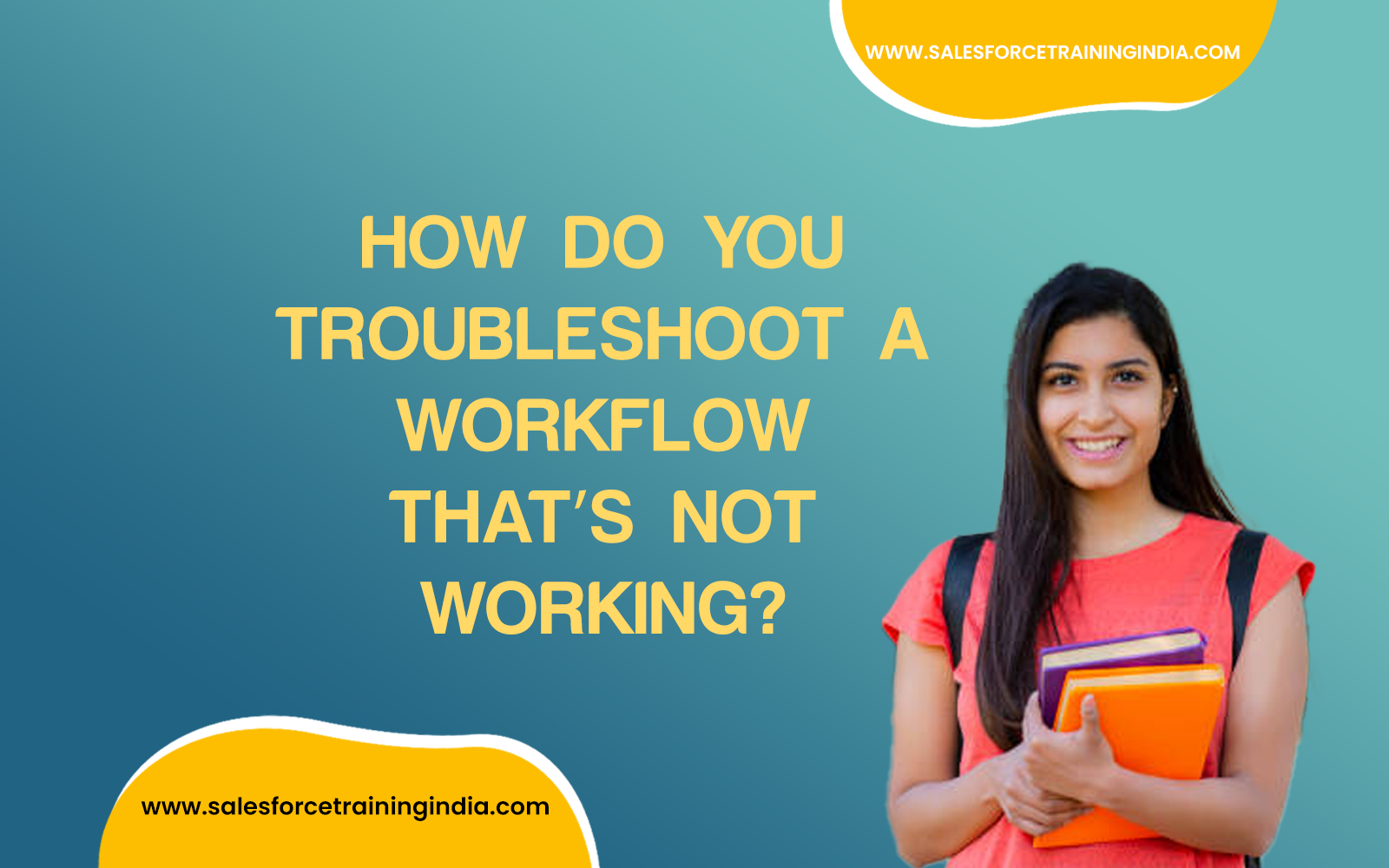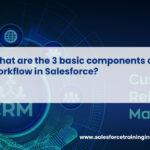Troubleshooting a non-functioning workflow in Salesforce involves a systematic approach to identify and rectify the issue. The first step is to ensure that the workflow is active. If it’s inactive, it won’t trigger any of the defined actions. Next, verify that the criteria for triggering the workflow are correct and precise. It’s common for issues to arise due to misconfigured criteria that either are too broad or too narrow, causing the workflow not to fire as expected.
If the workflow is active and the criteria are correct, the next step is to check the actions defined in the workflow. Ensure that each action, whether it’s an email alert, field update, task creation, or outbound message, is configured correctly. For instance, in the case of email alerts, check the email template and recipient list.
Additionally, it’s important to review any applicable permissions and field-level security settings. Users need the appropriate permissions to execute the workflow actions, especially when it involves updating records. If everything seems configured correctly, Salesforce’s debug logs can be an invaluable tool. They provide detailed information on the workflow process, including when it was triggered and what actions were executed, helping to pinpoint where the process might be breaking down. This methodical approach usually uncovers the root cause of the issue, allowing for appropriate adjustments and ensuring the workflow operates as intended.
Frequently Asked Questions (FAQs)
How to debug a workflow in Salesforce?
To debug a workflow in Salesforce, you can utilize several tools and techniques to identify issues and ensure that the workflow rules are functioning correctly. One of the primary methods is to use the Debug Logs. Enable debug logs for the user who is triggering the workflow and set the appropriate logging level. When the workflow rule is executed, the debug logs will capture detailed information about the process, including whether the workflow criteria were met and which actions were executed. Additionally, you can use the Setup Audit Trail to track changes to workflow rules and ensure they are configured as expected.
How do I test a workflow in Salesforce?
To test a workflow in Salesforce, follow these steps to ensure that the workflow rule is triggering as expected:
- Create or update records that meet the criteria defined in the workflow rule. This can be done through the Salesforce user interface or by importing data.
- Monitor the actions triggered by the workflow rule, such as field updates, email alerts, tasks, or outbound messages. Verify that these actions are executed as specified.
- Use debug logs to capture detailed information about the workflow rule execution. This helps in understanding if the criteria were met and which actions were performed.
- Review the workflow rule history in the setup area to see the list of workflow rules that were triggered and their respective actions.
Is workflow going away in Salesforce?
Workflow rules are not being actively developed by Salesforce as they shift focus to more advanced automation tools like Process Builder and Flow Builder. While existing workflow rules will continue to function, Salesforce recommends transitioning to Process Builder and Flow Builder for new automation needs. These newer tools offer more flexibility, advanced capabilities, and a more user-friendly interface compared to traditional workflow rules.
What are the workflow limitations in Salesforce?
Salesforce workflow limitations include:
- Limited actions: Workflow rules can only perform four types of actions: field updates, email alerts, tasks, and outbound messages. They do not support more complex actions like creating or deleting records.
- No chaining: Workflow rules cannot call or trigger other workflow rules directly, limiting their ability to handle complex processes.
- Single criteria evaluation: Workflow rules can only evaluate criteria once per triggering event, unlike Process Builder, which can evaluate multiple criteria and handle more complex logic.
- Limited debugging: Debugging workflow rules can be challenging as there are fewer built-in tools compared to Process Builder and Flow Builder.
- Static timing: Time-dependent workflow actions are less flexible compared to the scheduling capabilities in Flow Builder.
How to find workflow rules in Salesforce?
To find workflow rules in Salesforce:
- Navigate to Setup in Salesforce.
- In the Quick Find box, type “Workflow Rules”.
- Click on “Workflow Rules” under Process Automation.
- You will see a list of workflow rules grouped by object. You can select an object to view and manage the workflow rules associated with that object.
Additionally, you can use Schema Builder to visually represent and locate workflow rules within your Salesforce organization.
Which actions cannot be performed via a workflow rule?
Actions that cannot be performed via a workflow rule in Salesforce include:
- Creating or deleting records: Workflow rules cannot create new records or delete existing records. These actions require Process Builder or Flow Builder.
- Invoking Apex code: Workflow rules cannot directly invoke Apex code or call Apex classes. This is possible with Process Builder and Flow Builder through invoking Apex actions.
- Complex branching logic: Workflow rules cannot handle complex branching logic or conditional actions that require evaluation of multiple criteria or nested conditions.
- User interactions: Workflow rules do not support actions that involve user interactions or require user inputs, which can be achieved using Visual Workflow (Flow Builder).
Which two conditions cause workflow rules to fire?
Workflow rules in Salesforce fire when two main conditions are met:
- Evaluation Criteria: This specifies when the workflow rule should be evaluated. The criteria can be set to evaluate when a record is created, when a record is created and every time it’s edited, or when a record is created and edited to subsequently meet the criteria.
- Rule Criteria: This defines the specific conditions that a record must meet for the workflow rule to fire. The rule criteria can be based on field values, formulas, or other logical expressions. When a record matches these criteria, the workflow rule triggers the specified actions.
What is the difference between workflow and flow in Salesforce?
The key difference between workflow and flow in Salesforce lies in their capabilities and use cases:
- Workflow: Workflow rules are more limited in functionality. They can perform basic automation tasks such as field updates, email alerts, tasks, and outbound messages. Workflow rules are easier to set up but are restricted to simpler use cases.
- Flow: Flow is a more powerful automation tool that can handle complex business processes. Flows can create, update, delete records, call Apex code, display screens for user interaction, and handle more advanced logic through conditions and loops. Flow Builder provides a visual interface to create flows, making it suitable for more sophisticated automation needs.
How many types of workflows are there in Salesforce?
In Salesforce, there is essentially one type of workflow which can execute four types of actions:
- Field Updates
- Email Alerts
- Tasks
- Outbound Messages
While workflows are limited to these actions, they can be configured in various ways to address different business requirements.
Can we convert workflow to flow in Salesforce?
Currently, there is no direct tool or feature in Salesforce to convert a workflow to a flow automatically. However, you can manually recreate the functionality of a workflow rule using Flow Builder. This involves analyzing the workflow rule’s criteria and actions, and then replicating them within a flow. This manual process allows for more advanced customization and optimization of the automation process.
What are the 5 types of flow Salesforce?
The five types of flow in Salesforce are:
- Screen Flow: Used to create interactive flows that guide users through a series of screens.
- Auto-launched Flow: Triggered automatically by events, processes, or Apex code, without user interaction.
- Scheduled Flow: Runs at a specified time and frequency, automating repetitive tasks.
- Record-Triggered Flow: Executes when records are created or updated, similar to workflow rules but with more advanced capabilities.
- Platform Event-Triggered Flow: Initiated by platform events, allowing for real-time responses to external systems and processes.
How to optimize flows in Salesforce?
To optimize flows in Salesforce:
- Minimize Complexity: Keep flows simple and modular to reduce maintenance and improve performance. Break down complex processes into smaller, reusable sub-flows.
- Optimize Queries: Limit the number of records queried and updated to avoid hitting governor limits. Use filters and conditions to narrow down the data set.
- Bulkify Flows: Design flows to handle bulk data processing efficiently. Use loops and collections to process multiple records in a single transaction.
- Error Handling: Implement robust error handling to manage exceptions gracefully and provide meaningful feedback to users.
- Test Thoroughly: Test flows in a sandbox environment to identify and resolve performance bottlenecks and logic errors before deploying to production.
How many flows can be active in Salesforce?
In Salesforce, there is no explicit limit on the number of active flows an organization can have. However, best practices recommend managing and optimizing flows carefully to ensure efficient performance and maintainability. It’s crucial to monitor flow performance and governor limits to avoid potential issues that could arise from having a large number of active flows. Regular audits and reviews of active flows can help maintain a streamlined and efficient automation environment.
What is the difference between flow and trigger in Salesforce?
The key difference between flow and trigger in Salesforce lies in their functionality and use cases:
- Flow: A flow is a declarative tool that allows you to automate complex business processes using a visual interface. Flows can perform various actions such as creating, updating, deleting records, sending emails, calling Apex code, and displaying screens for user interaction. Flows are flexible and can be used for both simple and complex automation scenarios without requiring code.
- Trigger: A trigger is a piece of Apex code that executes before or after specific database events on a particular object, such as insert, update, delete, or undelete. Triggers are more powerful and flexible than flows but require programming knowledge. They are used for scenarios that require precise control over the execution order and complex logic that cannot be easily achieved with flows.
Why we use trigger instead of workflow?
We use trigger instead of workflow when more advanced and complex logic is required that cannot be accomplished with workflow rules. Triggers are capable of:
- Handling complex business logic: Triggers can execute custom Apex code to handle sophisticated business requirements that workflows cannot.
- Performing multiple DML operations: Triggers can perform multiple operations on different objects in a single transaction, which workflows are limited in doing.
- Executing before and after events: Triggers can be set to execute both before and after record modifications, providing more granular control over data manipulation.
- Calling external services: Triggers can call external web services and handle asynchronous processing, which workflows do not support.
What executes first flow or trigger?
When a record is created or updated, triggers execute first before flows. Specifically:
- Before triggers: Execute before any record is saved to the database.
- Validation rules: Run after before triggers.
- After triggers: Execute after the record has been saved to the database.
- Processes and flows: Record-triggered flows (and Process Builder processes) execute after the after triggers.
This order ensures that all necessary validations and data manipulations are performed before flows handle any additional automation tasks.
Can a Salesforce flow trigger itself?
A Salesforce flow cannot trigger itself directly to prevent infinite loops and ensure system stability. However, a flow can trigger other processes that might indirectly lead to the flow being executed again under specific circumstances. It’s essential to design flows carefully to avoid unintended recursion and ensure efficient processing.
How do I create a fault in flow in Salesforce?
To create a fault in flow in Salesforce, follow these steps:
- Drag the Fault Connector: In Flow Builder, drag the fault connector from the element that might cause an error (e.g., data update, record create).
- Configure Fault Handling: Connect the fault path to a fault-handling element such as a screen or a separate action to handle the error gracefully.
- Add Error Messages: Use the error message to display a user-friendly message or log the error for debugging purposes.
- Test the Flow: Intentionally cause an error condition (e.g., by violating a validation rule) to ensure the fault handling path is executed correctly.
By properly setting up fault handling, you can manage errors effectively and provide users with meaningful feedback.
Can one flow trigger another flow in Salesforce?
Yes, one flow can trigger another flow in Salesforce. This is achieved by using a subflow element in the primary flow. To do this:
- Add Subflow Element: In Flow Builder, drag the Subflow element onto the canvas.
- Select the Flow: Choose the flow you want to trigger from the list of available flows.
- Pass Parameters: If necessary, pass input parameters from the primary flow to the subflow to ensure it has the data it needs to execute correctly.
- Configure Execution: Define the conditions under which the subflow should be triggered to ensure seamless integration between the flows.
How do I bypass a trigger in Salesforce flow?
To bypass a trigger in Salesforce flow, you can use a custom field or custom setting/metadata to control the execution of the trigger. Here’s how:
- Create a Custom Field: Add a checkbox field on the object that the trigger runs on (e.g.,
Bypass_Trigger__c). - Modify the Trigger Code: Update the trigger code to check the value of this custom field. If the checkbox is checked, the trigger logic is bypassed.
if (!Trigger.isExecuting && !record.Bypass_Trigger__c) { // Trigger logic here } - Set the Field in Flow: In the flow, set the custom field (
Bypass_Trigger__c) totruebefore performing operations that would otherwise trigger the Apex code.
This method allows you to conditionally bypass the trigger logic when needed, providing greater control over your automation processes.
How do I debug a trigger flow in Salesforce?
To debug a trigger flow in Salesforce, you can use the following steps:
- Enable Debug Logs: Set up debug logs for the user who triggers the flow. This can be done in the Setup menu under
Debug Logs. - Add Debug Statements: Add debug statements in the trigger and Apex code using
System.debug(). This will log important information to help trace the execution flow. - Use Flow Debugging Tools: In Flow Builder, use the
Debugoption to run the flow in debug mode. This allows you to step through the flow and see the values of variables and the outcome of each step. - Review Debug Logs: After running the flow, review the debug logs to identify where the flow or trigger might be failing. Look for errors or unexpected values in the logs.
By using these debugging techniques, you can identify and resolve issues in your trigger flows more effectively.
How do I trigger a flow in Salesforce?
To trigger a flow in Salesforce, you can use various methods depending on the type of flow:
- Record-Triggered Flow: Configure the flow to start when a record is created or updated. This is set in the flow’s start element settings.
- Schedule-Triggered Flow: Schedule the flow to run at specific times using the schedule trigger option in Flow Builder.
- Platform Event-Triggered Flow: Configure the flow to start when a specific platform event is received.
- Auto-Launched Flow: Call the flow from an Apex class, Process Builder, or another flow using the
Flow.Interviewclass in Apex or the Subflow element in Flow Builder. - Screen Flow: Embed the flow in a Lightning page or use a button or link to launch the flow.
Each method allows you to integrate flows into your Salesforce processes based on your specific needs.
How do I break a loop in Salesforce flow?
To break a loop in Salesforce flow, use the Loop element and Decision elements to control the iteration. While Salesforce Flow does not have a direct “break” statement like traditional programming languages, you can achieve similar functionality by using decisions to conditionally exit the loop. Here’s how:
- Set Up the Loop: Create a collection variable and use the Loop element to iterate over the collection.
- Decision Element: Within the loop, use a Decision element to evaluate a condition that determines if the loop should continue or exit.
- Update Loop Variable: If the condition is met, update a variable or use a separate element to stop further processing.
By using these elements, you can effectively control the flow of your loop and exit early when necessary.
What are the 4 actions we can perform using workflow rules?
The four actions we can perform using workflow rules in Salesforce are:
- Field Updates: Automatically update the value of a field on a record. This is useful for setting default values, updating statuses, or performing calculations.
- Email Alerts: Send automated email notifications to designated recipients when the workflow criteria are met. This helps in alerting stakeholders about important changes or events.
- Tasks: Create tasks for users to complete. This ensures that follow-up actions are assigned and tracked appropriately.
- Outbound Messages: Send SOAP messages to external systems with data from Salesforce. This allows integration with external applications and systems for seamless data exchange.
Are you ready to elevate your Salesforce skills? Dive into our specialized Salesforce training in Hyderabad, meticulously designed to provide hands-on experience and real-time knowledge. Our comprehensive, project-based course ensures you gain practical skills with daily notes, engaging projects, and targeted preparation for certifications and interviews, preparing you thoroughly for the dynamic Salesforce ecosystem.
Don’t hesitate to boost your career prospects. Enroll today in our Salesforce course for beginners and benefit from personalized mentorship by seasoned instructors. Whether you’re starting fresh or aiming to refine your Salesforce expertise, our tailored program in Hyderabad is crafted to support your professional growth. Take charge of your career journey with us today.




